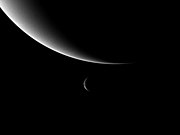- For a timeline of discovery dates, see Timeline of discovery of Solar System planets and their moons
Neptune has 13 known moons.[7] The largest by far, comprising more than 99.5 percent of the mass in orbit around Neptune[106] and the only one massive enough to be spheroidal, is Triton, discovered by William Lassell just 17 days after the discovery of Neptune itself. Unlike all other large planetary moons in the Solar System, Triton has a retrograde orbit, indicating that it was captured rather than forming in place; it probably was once a dwarf planet in the Kuiper belt.[107] It is close enough to Neptune to be locked into a synchronous rotation, and it is slowly spiraling inward because of tidal acceleration and eventually will be torn apart, in about 3.6 billion years, when it reaches the Roche limit.[108] In 1989, Triton was the coldest object that had yet been measured in the solar system,[109] with estimated temperatures of −235 °C (38 K).[110]
Neptune's second known satellite (by order of discovery), the irregular moon Nereid, has one of the most eccentric orbits of any satellite in the solar system. The eccentricity of 0.7512 gives it an apoapsis that is seven times its periapsis distance from Neptune.[111]

From July to September 1989, Voyager 2 discovered six new Neptunian moons.[56] Of these, the irregularly shaped Proteus is notable for being as large as a body of its density can be without being pulled into a spherical shape by its own gravity.[112] Although the second-most-massive Neptunian moon, it is only one-quarter of one percent the mass of Triton. Neptune's innermost four moons—Naiad, Thalassa, Despina and Galatea—orbit close enough to be within Neptune's rings. The next-farthest out, Larissa was originally discovered in 1981 when it had occulted a star. This occultation had been attributed to ring arcs, but when Voyager 2 observed Neptune in 1989, it was found to have been caused by the moon. Five new irregular moons discovered between 2002 and 2003 were announced in 2004.[113][114] As Neptune was the Roman god of the sea, the planet's moons have been named after lesser sea gods.[38]
Observation
Neptune is never visible to the naked eye, having a brightness between magnitudes +7.7 and +8.0,[7][11] which can be outshone by Jupiter's Galilean moons, the dwarf planet Ceres and the asteroids 4 Vesta, 2 Pallas, 7 Iris, 3 Juno and 6 Hebe.[115] A telescope or strong binoculars will resolve Neptune as a small blue disk, similar in appearance to Uranus.[116]
Because of the distance of Neptune from the Earth, the angular diameter of the planet only ranges from 2.2–2.4 arcseconds;[7][11] the smallest of the Solar System planets. Its small apparent size has made it challenging to study visually; most telescopic data was fairly limited until the advent of Hubble Space Telescope and large ground-based telescopes with adaptive optics.[117][118]
From the Earth, Neptune goes through apparent retrograde motion every 367 days, resulting in a looping motion against the background stars during each opposition. These loops will carry it close to the 1846 discovery coordinates in April and July 2010 and in October and November 2011.[90]
Observation of Neptune in the radio frequency band shows that the planet is a source of both continuous emission and irregular bursts. Both sources are believed to originate from the planet's rotating magnetic field.[49] In the infrared part of the spectrum, Neptune's storms appear bright against the cooler background, allowing the size and shape of these features to be readily tracked.[119]
Exploration
Voyager 2's closest approach to Neptune occurred on August 25, 1989. Since this was the last major planet the spacecraft could visit, it was decided to make a close flyby of the moon Triton, regardless of the consequences to the trajectory, similarly to what was done for Voyager 1's encounter with Saturn and its moon Titan. The images relayed back to Earth from Voyager 2 became the basis of a 1989 PBS all-night program, Neptune All Night.[120]
During the encounter, signals from the spacecraft required 246 minutes to reach the Earth. Hence, for the most part, the Voyager 2 mission relied on pre-loaded commands for the Neptune encounter. The spacecraft performed a near-encounter with the moon Nereid before it came within 4400 km of Neptune's atmosphere on August 25, then passed close to the planet's largest moon Triton later the same day.[121]
The spacecraft verified the existence of a magnetic field surrounding the planet and discovered that the field was offset from the centre and tilted in a manner similar to the field around Uranus. The question of the planet's rotation period was settled using measurements of radio emissions. Voyager 2 also showed that Neptune had a surprisingly active weather system. Six new moons were discovered, and the planet was shown to have more than one ring.[56][121]
In 2003, there was a proposal to NASA's "Vision Missions Studies" to implement a "Neptune Orbiter with Probes" mission that does Cassini-level science without fission-based electric power or propulsion. The work is being done in conjunction with JPL and the California Institute of Technology.[122]
See also
- Neptune in astrology
- Neptune in fiction
- Colonization of Neptune
- Neptune Orbiter – proposed space probe to Neptune (not before 2035- may have been indefinitely postponed, as NASA's Strategic Exploration Plan no longer includes it)
- Neptune Trojan – asteroids orbiting in Neptune's Lagrangian points
- The Planets – Neptune is one of the seven movements in Gustav Holst's orchestral suite, The Planets





No comments:
Post a Comment